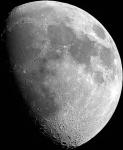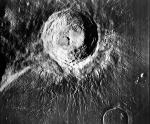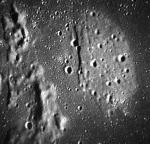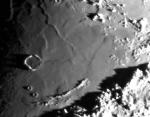|
 Ranger Cratering
Ranger Cratering
5.08.2004 | Lunnoe foto dnya
Identification of craters made by spacecraft impact on the Moon is valuable because it permits calibration of impact energy and crater size relations. And its fun. The camera failure on the otherwise successful Ranger 6 meant that it's exact crash point is unknown.
 A New Way to Image the Moon
A New Way to Image the Moon
4.08.2004 | Lunnoe foto dnya
LPOD is about increasing scientific understanding and enjoyment of the Moon, with art and history and culture thrown in to keep us from becoming nerds. But today's LPOD is all about technique, because it is so unusual.
 Still on the Limb
Still on the Limb
3.08.2004 | Lunnoe foto dnya
Last year when historically great librations were tilting the west limb of the Moon into view, Fred Ringwald took this high sun image of the Orientale Basin. Now do you see why I am always encouraging people to observe when the sun is high?
 Jupiter Graze
Jupiter Graze
2.08.2004 | Lunnoe foto dnya
The Moon is huge - in our sky. This is brought home every time any other planet is in the same eyepiece field with Luna. On January 26, 2002, Jupiter grazed the Moon's southeast limb, at least as seen from Mike Tyrrell's backyard in the United Kingdom.
 Another Day, Another Success
Another Day, Another Success
1.08.2004 | Lunnoe foto dnya
The Lunar Orbiter program, which acquired high resolution images of the lunar surface to help identify safe landing sites for Apollo, was the most successful of America's lunar efforts. There were 5 missions...
 40 Years Since Impact
40 Years Since Impact
31.07.2004 | Lunnoe foto dnya
Forty years ago today, the US lunar exploration program finally found success. After a series of embarassing failures, the rocket, the navigation and the cameras all worked, and Ranger 7 radioed back to Earth about 4000 images of ever increasing resolution as it approached and finally slammed into the Moon.
 Obliquely Viewed Fault
Obliquely Viewed Fault
30.07.2004 | Lunnoe foto dnya
One of the most famous features on the Moon - certainly as judged by the number of image submissions to LPOD - is the Straight Wall. Until chancing upon this image in the online Apollo Image Atlas at the Lunar & Planetary Institute, I though that the Wall had not been photographed during the Apollo program.
 EAW & GPK
EAW & GPK
29.07.2004 | Lunnoe foto dnya
Ewen Whitaker and Gerard Kuiper (in tie) looking at a photo of the landing site for Ranger 6, as the spacecraft sped towards the Moon on Feb 1, 1964. Ranger 6 hit the Moon the next day very near its target in western Mare Tranquilitatis. But as the solemn faces foretold, no photos were taken.
 Cognitum Kipuka
Cognitum Kipuka
28.07.2004 | Lunnoe foto dnya
Kipuka is a Hawaiian word for an island. In volcanology it is an island of older land surrounded by a younger lava flow. In the middle of Mare Cognitum - the Known Sea (known because it is where Ranger 7 acquired the first high resolution images of the Moon) - are a number of kipukas.
 What is a Dome?
What is a Dome?
27.07.2004 | Lunnoe foto dnya
I know what a lunar dome is. Its a perfectly symmetrical mare rise, low-sloped and preferably topped with a summit pit. The Hortensius domes and the dome near Kies are the ideals of lunar domes. But I am broad minded, so I also call the steeper-sided, rougher textured, pitless low hills near Arago domes too.

